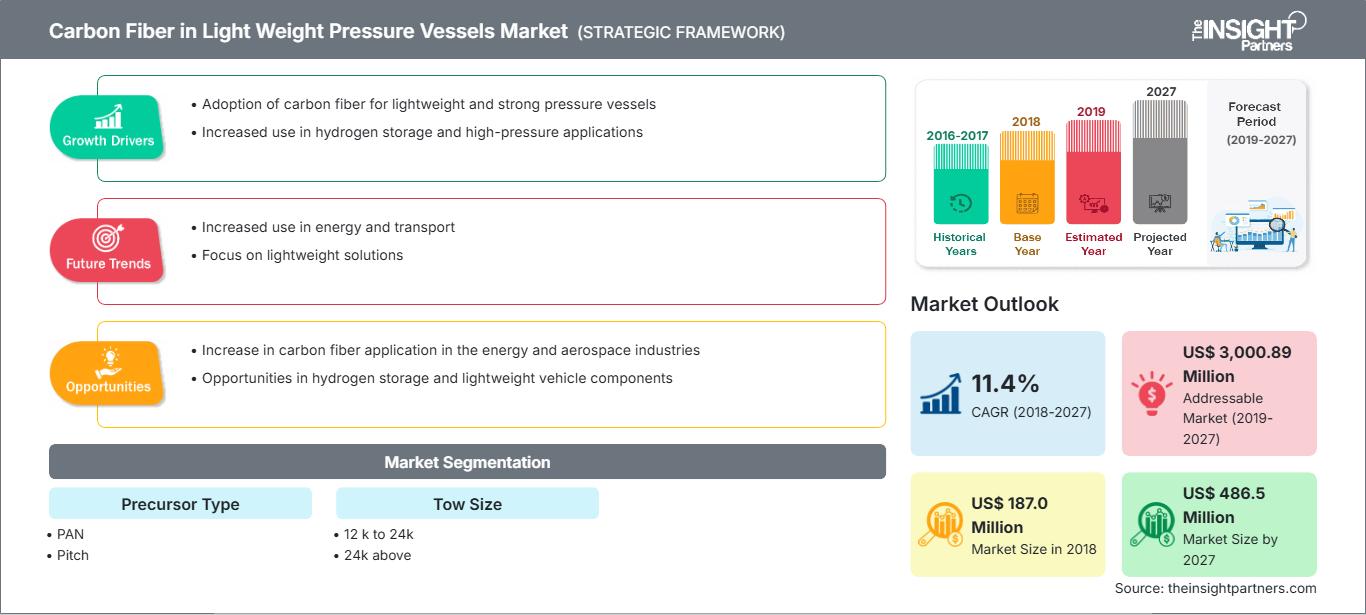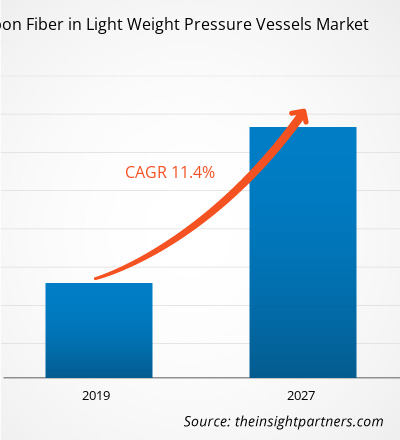2018 年,全球轻型压力容器碳纤维市场规模达 1.87 亿美元,预计在 2019 - 2027 年预测期内,复合年增长率将达到 11.4%,到 2027 年将达到 4.865 亿美元。
亚太地区是碳纤维压力容器增长最快的地区,这归因于印度、中国和日本等国人口不断增长、政府对环境问题的日益关注,以及对节能环保 CNG 汽车的日益关注。此外,汽车行业日益增长的需求也有望推动该地区碳纤维轻型压力容器市场的增长。
市场洞察:汽车和工业应用需求的不断增长为碳纤维轻型压力容器市场的增长提供了机遇
碳纤维具有高模量和比强度、高疲劳强度、高刚度、高耐压能力、较低的热膨胀系数、耐腐蚀等有益特性,可用于汽车和其他工业应用的压力容器。此外,轻质材料需求的不断增长,以及政府减少有害气体排放和提高燃油效率的举措,预计将推动碳纤维在汽车应用领域的轻型压力容器市场的发展。
自定义此报告以满足您的要求
您将免费获得任何报告的定制,包括本报告的部分内容,或国家级分析、Excel 数据包,以及为初创企业和大学提供超值优惠和折扣
碳纤维在轻型压力容器市场: 战略洞察

- 获取本报告的主要市场趋势。这个免费样本将包括数据分析,从市场趋势到估计和预测。
燃料电池汽车中碳纤维压力容器的应用日益广泛,将为全球轻质压力容器用碳纤维市场创造增长机会。
您将免费获得任何报告的定制,包括本报告的部分内容,或国家级分析、Excel 数据包,以及为初创企业和大学提供超值优惠和折扣
碳纤维在轻型压力容器市场: 战略洞察

- 获取本报告的主要市场趋势。这个免费样本将包括数据分析,从市场趋势到估计和预测。
预计全球轻质压力容器用碳纤维市场对用于储存高压氢气的密封容器用碳纤维的需求将不断增长。碳纤维被认为是生产可靠安全压力容器的最佳选择,因为它能够承受氢气的高压,因此全球汽车制造商越来越多地参与燃料电池汽车的研发,各国政府也为燃料电池汽车的生产提供基础设施建设支持。
前驱体洞察
根据前驱体,全球轻质压力容器用碳纤维市场细分为聚丙烯腈 (PAN) 和沥青。聚丙烯腈 (PAN) 细分市场引领着全球轻质压力容器用碳纤维市场。聚丙烯腈 (PAN) 是一种含碳量约为 68% 的碳纤维,是应用最广泛的碳纤维前驱体之一。 PAN 由丙烯腈 (AN) 在常用的抑制剂(例如偶氮化合物和过氧化物)的作用下通过聚合工艺聚合而成。轻型压力容器对碳纤维的需求不断增长,带动了 PAN 的制造和生产激增,因为它是最广泛使用的前体之一。
丝束尺寸洞察
全球轻型压力容器用碳纤维市场按丝束尺寸细分为 12k 至 24k 和 24k 以上。12k 至 24k 细分市场在全球轻型压力容器用碳纤维市场中占据最大份额。12k 至 24k 丝束尺寸碳纤维的厚重和高刚性特性在军事和科学设备应用中非常有益,这也是推动全球 12k 至 24k 丝束尺寸碳纤维增长和扩张的主要因素。生产 12K 至 24K 碳纤维的一些主要关键参与者包括东丽复合材料美国公司、帝人株式会社、SGL 集团等。
轻型压力容器中的碳纤维市场区域洞察
The Insight Partners 的分析师已详尽阐述了预测期内影响轻型压力容器碳纤维市场的区域趋势和因素。本节还讨论了北美、欧洲、亚太地区、中东和非洲以及南美和中美洲轻型压力容器碳纤维市场的细分市场和地域分布。
碳纤维在轻型压力容器中的市场报告范围
| 报告属性 | 细节 |
|---|---|
| 市场规模 2018 | US$ 187.0 Million |
| 市场规模 2027 | US$ 486.5 Million |
| 全球复合年增长率 (2018 - 2027) | 11.4% |
| 历史数据 | 2016-2017 |
| 预测期 | 2019-2027 |
| 涵盖的领域 |
By 前驱体类型
|
| 覆盖地区和国家 | 北美
|
| 市场领导者和主要公司简介 |
|
轻型压力容器市场参与者的碳纤维密度:了解其对业务动态的影响
轻型压力容器中的碳纤维市场正在快速增长,这得益于终端用户需求的不断增长,而这些需求的驱动因素包括消费者偏好的演变、技术进步以及对产品优势的认知度的提升。随着需求的增长,企业正在扩展产品线,不断创新以满足消费者需求,并抓住新兴趋势,从而进一步推动市场增长。

- 获取 碳纤维在轻型压力容器市场 主要参与者概述
并购、投资场景、新产品开发等被视为全球轻质压力容器碳纤维市场最常采用的策略。全球轻型压力容器碳纤维市场的一些最新发展如下:
- 2019 年:帝人株式会社同意收购 Renegade Materials Corporation(Renegade),帝人旨在通过收购加强其碳纤维和中间材料业务,以保持其作为航空航天应用解决方案领先供应商的地位。
- 2018 年:东丽工业公司与荷兰皇家 Ten Cate BV 达成协议,收购其子公司 TenCate Advanced Composites Holding BV 的所有股份。此次收购预计将产生巨大的协同效应,将后者的产品系列与碳纤维和聚合物技术相结合。
- 2017 年:赫氏推出了 MAXIM,这是一项由政府资助的新业务,用于碳纤维织物的研发,并扩建了其在莱斯特的制造工厂。
全球轻型压力容器碳纤维船舶市场细分
按前体划分
- 聚丙烯腈 (PAN)
- 节距
按丝束尺寸划分
- 12k 至 24k
- 以上24k
按地理位置
北美洲
- 美国
- 加拿大
- 墨西哥
欧洲
- 德国
- 法国
- 意大利
- 英国
- 俄罗斯
- 其他地区欧洲
亚洲太平洋地区
- 澳大利亚
- 中国
- 印度
- 日本
- 韩国
- 亚太其他地区
世界其他地区
- 巴西
- 阿根廷
- 南美洲其他地区 (SAM)
公司简介
- 晓星株式会社
- 索尔维
- 台塑株式会社
- 东丽株式会社
- 帝人株式会社
- 西格里碳素公司
- 三菱化学株式会社
- 吴羽株式会社
- 赫氏株式会社
- 多瓦克萨公司
- 历史分析(2 年)、基准年、预测(7 年)及复合年增长率
- PEST和SWOT分析
- 市场规模、价值/数量 - 全球、区域、国家
- 行业和竞争格局
- Excel 数据集
近期报告
相关报告
客户评价
购买理由
- 明智的决策
- 了解市场动态
- 竞争分析
- 客户洞察
- 市场预测
- 风险规避
- 战略规划
- 投资论证
- 识别新兴市场
- 优化营销策略
- 提升运营效率
- 顺应监管趋势




















 获取免费样品 - 碳纤维在轻型压力容器市场
获取免费样品 - 碳纤维在轻型压力容器市场